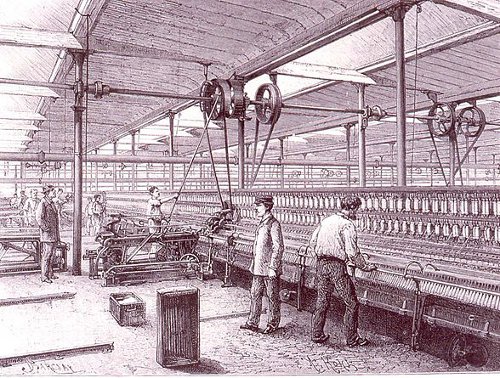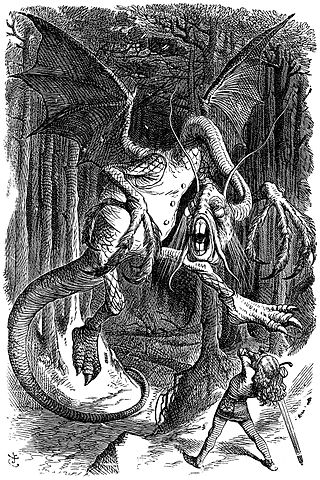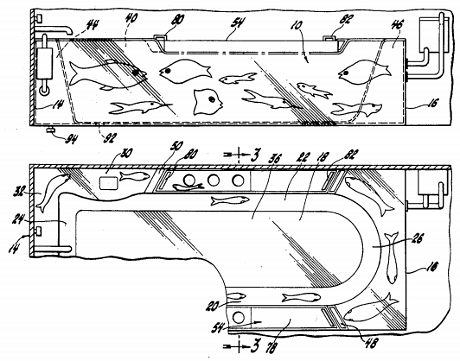In 2005 Toronto artist Brian Joseph Davis assembled more than 5,000 film taglines into one long narrative.
This version, read by voice-over artist Scott Taylor, is only an excerpt — the whole thing runs to 22 pages (PDF).
In 2005 Toronto artist Brian Joseph Davis assembled more than 5,000 film taglines into one long narrative.
This version, read by voice-over artist Scott Taylor, is only an excerpt — the whole thing runs to 22 pages (PDF).

Suppose that, at a given moment, a certain number of people are engaged in the manufacture of pins. They make as many pins as the world needs, working (say) eight hours a day. Someone makes an invention by which the same number of men can make twice as many pins: pins are already so cheap that hardly any more will be bought at a lower price. In a sensible world, everybody concerned in the manufacturing of pins would take to working four hours instead of eight, and everything else would go on as before. But in the actual world this would be thought demoralizing. The men still work eight hours, there are too many pins, some employers go bankrupt, and half the men previously concerned in making pins are thrown out of work. There is, in the end, just as much leisure as on the other plan, but half the men are totally idle while half are still overworked. In this way, it is insured that the unavoidable leisure shall cause misery all round instead of being a universal source of happiness. Can anything more insane be imagined?
— Bertrand Russell, “In Praise of Idleness,” 1935

Eric Clapton grew up believing that his grandparents were his parents and that his mother was his sister. His real father had deserted the family, and they had adopted this fiction in order to spare him the stigma of illegitimacy.
“It occurs to me that the family had no real idea of how to explain my own existence to me,” he wrote in his 2007 autobiography, Clapton. “The guilt attached to that made them very aware of their own shortcomings, which would go a long way in explaining the anger and awkwardness that my presence aroused in almost everybody.”
One other striking detail from that book: He mentions that buying a yacht at age 60 was “the first time in my life I had to borrow money to pay for something.” This seems to mean that, ever since stardom had found him at age 18, he could simply acquire anything he wanted.

“Jabberwocky” works wonderfully in German — writer Thomas Chatterton offered this translation to Macmillan’s Magazine in 1872:
Es brillig war. Die schlichte Toven
Wirrten und wimmelten in Waben;
Und aller-mümsige Burggoven
Die mohmen Räth’ ausgraben.
»Bewahre doch vor Jammerwoch!
Die Zähne knirschen, Krallen kratzen!
Bewahr’ vor Jubjub-Vogel, vor
Frumiösen Banderschnätzchen!«
Er griff sein vorpals Schwertchen zu,
Er suchte lang das manchsam’ Ding;
Dann, stehend unten Tumtum Baum,
Er an-zu-denken-fing.
Als stand er tief in Andacht auf,
Des Jammerwochen’s Augen-feuer
Durch tulgen Wald mit wiffek kam
Ein burbelnd Ungeheuer!
Eins, Zwei! Eins, Zwei! Und durch und durch
Sein vorpals Schwert zerschnifer-schnück,
Da blieb es todt! Er, Kopf in Hand,
Geläumfig zog zurück.
»Und schlugst Du ja den Jammerwoch?
Umarme mich, mien Böhm’sches Kind!
O Freuden-Tag! O Halloo-Schlag!«
Er chortelt froh-gesinnt.
Es brillig war. Die schlichte Toven
Wirrten und wimmelten in Waben;
Und aller-mümsige Burggoven
Die mohmen Räth’ ausgraben.
In The Philosopher’s Alice, Peter Heath calls this “easily the best” of the poem’s many translations. “In no other language is elaboration of structure so readily compatible with entire absence of meaning.”

On learning that weather erodes granite one inch every 100,000 years, sculptor Gutzon Borglum added an extra three inches to each president’s features on Mount Rushmore.
“Three inches would require 300,000 years to bring the work down to the point that I would like to finish it,” he said. “In other words, the work will not be done for another 300,000 years, as it should be.”
(Thanks, Matt.)
polysemant
n. a word having more than one meaning
In 1000 Most Obscure Words, lexicographer Norman Schur notes that the Oxford English Dictionary gives three strikingly different definitions for rosmarine:
rosemary
sea spray
the walrus
Similarly, merkin manages to mean both “an artificial covering of hair for the female pubic region” and “a mop to clean cannon.” Kudos.
In 1973, textile merchant Marcus Shloimovitz sued the Oxford Dictionary for defining Jew in part as “a grasping or extortionate money-lender or usurer.” “The Jewish race includes sages, scholars, judges, scientists and people from the arts and stage,” he argued. “They have done great service for their countries. They are not cheats or unscrupulous usurers.” He lost because he failed to show that the definition had caused him personal suffering.

In 1839, Louisville physician John Croghan opened a tuberculosis hospital inside Kentucky’s Mammoth Cave. Thinking that the steady temperature and humidity would help restore his patients, he built a few small buildings deep inside the cave, and a number of patients moved in for several months. A guide from the period reads:
Immediately beyond the Great Bend, a row of cabins, built for consumptive patients, commences. All of these are framed buildings, with the exception of two, which are of stone. They stand in line, from thirty to one hundred feet apart, exhibiting a picturesque, yet at the same time, a gloomy and mournful appearance. They are well furnished, and without question, would with good and comfortable accommodations, pure air and uniform temperature, cure the pulmonary consumption.
But morale in the sunless environment was low, and the close air made their condition worse. Patient Oliver Hazard Perry Anderson wrote, “I left the cave yesterday under the impression that I would be better out than in as my lungs were constantly irritated with smoke and my nose offended by a disagreeable effluvia, the necessary consequence of its being so tenanted without ventilation.”
Croghan ended the experiment after five months, and himself died of TB six years later.
(Thanks, Sandy.)
In 2009 experimental poet Robert Fitterman erased most of The Sun Also Rises, retaining only phrases that begin with the word I. The result can sound strangely like the diary entry of a random Saturday afternoon:
I went up to the flat. I put the mail on the table. I heard the door-bell pull. I put on a bathrobe and slippers. I filled the big earthenware jug with water. I dressed slowly. I felt tired and pretty rotten. I took up the brandy bottle. I went to the door. I found some ash-trays and spread them around. I looked at the count. I had that feeling of going through something that has already happened before. I had the feeling as in a nightmare of it all being something repeated, something I had been through and that now I must go through again. I took a note out of my pocket. I looked back and there were three girls at his table. I gave him twenty francs and he touched his cap. I went upstairs and went to bed.
Of Hemingway, Tom Wolfe said, “People always think that the reason he’s easy to read is that he is concise. He isn’t. The reason Hemingway is easy to read is that he repeats himself all the time, using ‘and’ for padding.”

In 1980 Michigan inventor Lawrence Robinson suggested wrapping an aquarium around a bathtub so that fish lovers can bathe with their pets:
This invention relates to a bathing fixture or tub such as ordinarily employed in the home, which also is an aquarium. The device may be used in the normal manner in the typical home bathroom, but it also provides the unique feature of an aquarium. The aquarium is so related to the bathing section of the tub that a bather will be literally surrounded by the aquarium creatures and/or plants while taking his or her bath.
I wonder what the fish think about this.